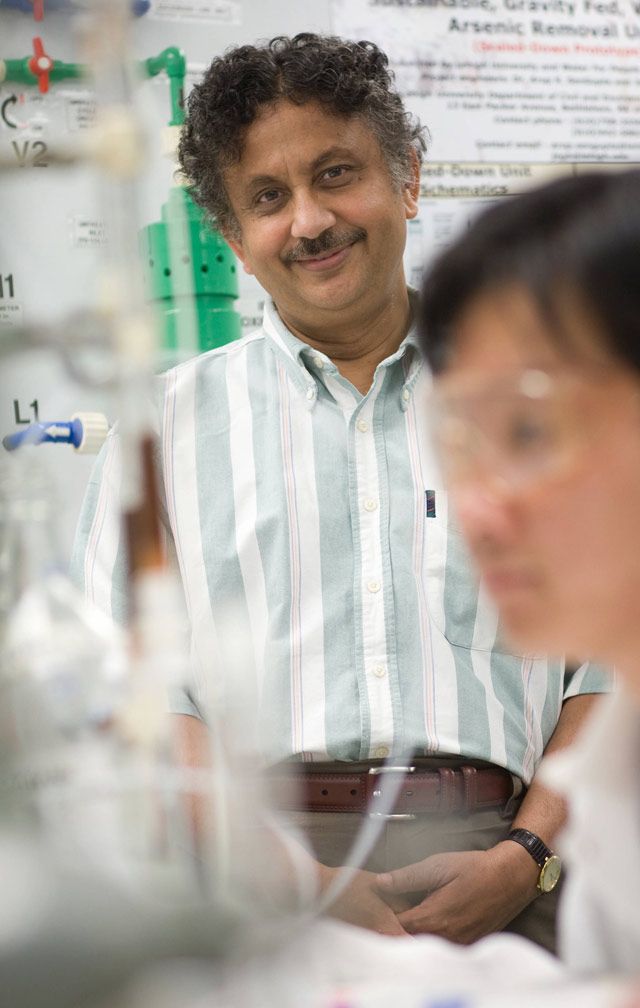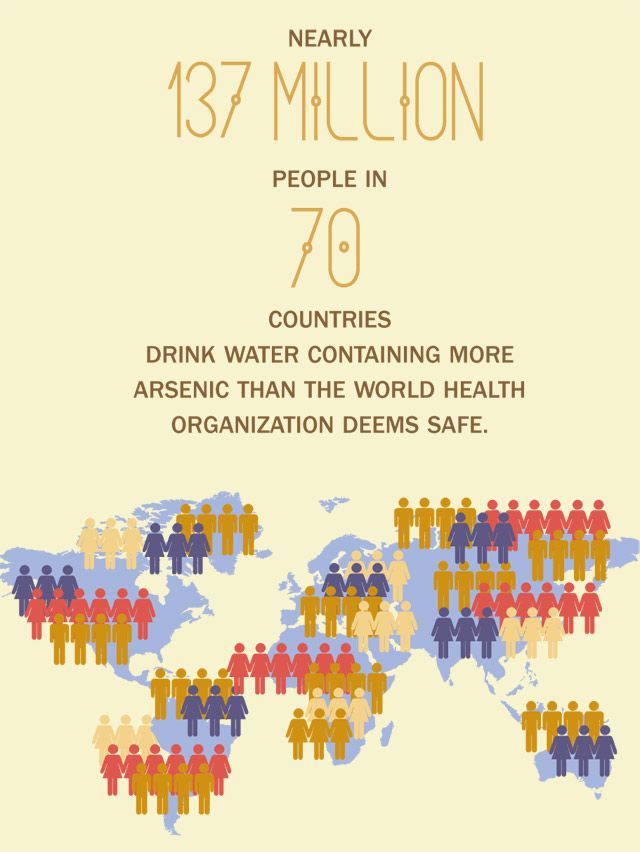CALLED TO CLEAN THE WORLD’S WATER, ARUP SENGUPTA FINDS INSPIRATION IN POETRY.
Water, water, every where,
And all the boards did shrink;
Water, water, every where,
Nor any drop to drink.
Two hundred years have passed since Samuel Taylor Coleridge wrote “The Rime of the Ancient Mariner,” but in some ways, says Arup SenGupta, little has changed.
Like the sailors in Coleridge’s poem, too many of the world’s people still cast a longing eye on abundant water that cannot be safely consumed.
Modern technology may make it possible to remove almost any toxin from water, says SenGupta, but millions of people still rely on groundwater that contains arsenic, fluoride and other naturally occurring contaminants. The problem is huge across the developing world, from India to Cambodia to Ethiopia’s Rift Valley, but it is also prevalent in the United states and other industrialized nations.
SenGupta, the P.C. Rossin professor of civil and environmental engineering, fashions innovative and sustainable solutions to the problems of arsenic and fluoride contamination of groundwater.
He approaches his work with the optimism of an entrepreneur and the elegance of a poet.
“We want to offer a solution using science and technology,” he says. “As engineers it is rational for us to ask, ‘Is there tangible progress? Have we changed somebody’s life?’
“Knowledge is not enough; you must apply it. Willingness is not enough; you must act. Everything has a human component.”
A CHILDHOOD STEEPED IN VERSE
SenGupta draws inspiration from Rabindranath Tagore, an Indian social reformer whose poetry he learned growing up in the state of West Bengal in India.
“The highest education,” wrote Tagore, who won the Nobel Prize for Literature in 1913, “is that which does not merely give us information but makes our life in harmony with all existence.”
SenGupta has paid dual homage to Tagore. a decade ago, his youthful immersion in poetry blossomed and he himself began writing poems. “I come from a place where this was ingrained,” he says. “I want to write poems that others are unlikely to write.”
The economy of words and subjectivity of meaning in poems harmonize with his calling as a scientist, SenGupta says. “Poetry provides a level of inspiration which would never come, at least in my case, from science and engineering. Poetry helps me develop research questions with more clarity.”
Tagore also inspired the foundation SenGupta created to spread his patented ion-exchange technology across the developing world. The Tagore-SenGupta Foundation, supported by major prizes that SenGupta and his students have won (see chart on page 21), has helped bring sustainable water treatment systems to more than one million people on the Indian subcontinent, in Southeast Asia and in the developed world.
In the 1990s, SenGupta began working with Water for people and Bengal Engineering College to tackle arsenic contamination in West Bengal. Two decades earlier, governments and world organizations had drilled wells in India, Bangladesh and countries in Southeast Asia so that people would no longer have to drink from polluted rivers. This reduced dysentery, cholera and hepatitis, and slashed infant mortality rates, but unknowingly exposed millions to toxic levels of arsenic in the groundwater.
“DRIVEN BY SUFFERING”
Arsenic occurs naturally in some soils and underground rock strata and leaches into groundwater reserves. It is odorless, colorless and tasteless, and it is dangerous in minute quantities. Nearly 137 million people in 70 countries drink water containing more arsenic than the 10 parts per billion that the World Health Organization deems safe. Long-term consumption of even tiny amounts of arsenic can cause disfiguring and cancerous skin lesions.
SenGupta, who is also a professor of chemical engineering, notes that the U.S. also has a huge arsenic problem. But American communities filter arsenic out of well water, preventing illness and death. The response to arsenic contamination in America is driven by regulation, while in Asia, says SenGupta, “it’s driven by suffering.”
SenGupta began working in 1996 with Luis H. Cumbal ’05 Ph.D. to test and develop a material called a hybrid anion exchanger (HAIX). This filtering agent uses ferric oxide nanoparticles that bind arsenic dispersed inside a sP.C.al kind of porous, functionalized polymer. By engineering a structure that allows ferric oxide nanoparticles to make up almost 25 percent of the material’s mass, the researchers were able to achieve much higher adsorption of arsenate, arsenite and other contaminants than previously recorded.
“We worked seven years in the lab to produce just two grams of this material,” SenGupta says.
HAIX was patented in 2008, marketed as ArsenXnp and LayneRT and initially deployed in SARSAC (Sustainable Arsenic Removal System in Affected Community) units in small villages in eastern India, where clean water solved a health problem and allowed economic growth. SenGupta published his results in peer-reviewed journals so the SARSAC processes could be replicated elsewhere. SARSAC units have since been installed by other groups in Nepal and Laos.
Filtration columns utilizing HAIX can be inexpensively attached to wells that serve about 200 families, SenGupta says. HAIX materials can also be easily recharged or regenerated for reuse. This reduces operating costs and avoids environmental issues caused by disposal of contaminantladen filtration media. These factors combine to make safe water production sustainable, he says.
“The funding comes from tariffs paid by villagers, on the order of about 50 cents (U.S.) per family per month,” he says. “This income, in some cases, allows a community to employ a full-time worker to draw and deliver water and maintain the system.”
OUT OF CRISIS, OPPORTUNITY
“It also creates an opportunity to transform a crisis into a business, via technology. If I can transplant this technology there, then there is a huge opportunity for people to be employed and enjoy economic growth.”
Well-meaning efforts can sometimes produce unsustainable solutions, says SenGupta. new wells or rainwater collection systems in many parts of the developing world are designed so that villagers must carry buckets a kilometer or two every time they need water. The systems are good in an emergency, but they assign little value to human labor.
“We deliver a process where human labor is respected. our scale is large enough to be sustainable. For one family, it cannot be sustained. But a community of 200 families generates enough income to keep the system working.”
From the initial two grams of HAIX material that SenGupta and Cumbal produced, more than 40,000 cubic feet of the polymer have been sold to date. More than 1 million people around the world, from Southeast Asia to the American Southwest, now drink arsenic-safe water because of HAIX. In India, where SenGupta’s system has been installed in more than 200 villages, people suffering previously from arsenic poisoning have reported dramatic improvements to their health.
“We never expected this kind of project to exist in our village,” Phum Mali, chief of the Cambodian village of Po Ta Pang, says in a video on the Tagore-SenGupta foundation website. “it cleans the water and it means a lot to us.”
HAIX has also turned out to have unintended uses. At the damaged Fukushima nuclear plant in Japan, engineers are using the material to remove radioactive contaminants from cooling water.
“That’s the beauty of knowledge,” says SenGupta. “You never know what path a new technology is going to take.”
SenGupta recently turned his attention to the crisis of fluoride contamination in the groundwater of africa. Ethiopia, Kenya, Senegal and Tanzania are particularly affected, he says.
“In Ethiopia, people have been drinking groundwater for decades. It is treated, so it is safe, microbiologically speaking.” But in areas like the Rift Valley, the water is laden with fluoride, which interferes with the formation of healthy bones and teeth and can result in crippling skeletal deformities.
“Fluoride is not as toxic as arsenic, but it is a much larger crisis,” SenGupta says. In Ethiopia, where he recently traveled to identify university and NGO partners to field-test filtration solutions, communities use either bone char, a compound made by pulverizing and incinerating animal bones, or activated alumina, a common filter, to remove fluoride. But these materials can only be used once or twice and then must be disposed of.
“This is economically unsustainable and an environmental problem,” SenGupta says.
Fluoride is found in water in concentrations an order of magnitude higher than arsenic. And while an arsenic filtration system can run about a year before its filtering agent must be reactivated, operating a fluoride system for even a month, says SenGupta, is a challenge.
SenGupta’s group is developing an ion-exchange polymer tailored to remove fluoride by dispersing zirconium oxide nanoparticles. The material has been tested in the lab and promises to increase the time between recharges, thus reducing the cost and environmental impact. “A year will be difficult to achieve,” he says. “But we are looking at three or four months.”
IF NECESSARY, WALK ALONE
Closer to home, SenGupta has developed a process to help clean the “flowback water” produced when natural gas is liberated from Marcellus Shale formations by hydraulic fracturing, or fracking. This process uses high fluid pressure to fracture underground strata to release gas. It also releases water that has high concentrations of unusual ions such as barium and strontium and small amounts of radium, SenGupta says.
The science of removing these contaminants is not well known. SenGupta has developed a process, with a patent pending, that will soon be licensed and tested in the field. The goal is to remove ions so that water used in fracking can be recycled and safely reinjected into the underground rock formations.
“In this manner,” says SenGupta, “less fresh water will be used and less water will be wasted.”
SenGupta also has NSF funding to investigate efficiency in plants that desalinate brackish water for potable use. In Florida, Colorado, Arizona and other areas with rising population and limited water supplies, there is growing interest in reclaiming water pumped from deep wells. This water often has high concentrations of sodium, chloride and calcium, up to 4,000 parts per million. “You can feel the salinity with your tongue, and the water doesn’t taste good,” he says. The high salt content also poses problems for people with high blood pressure and other ailments.
Brackish water is purified by running it across membranes that trap the salt ions. About 20 percent of the water remains with the removed contaminants, leaving salty water that must be disposed of. The membranes must also be chemically descaled in order to be effective over the long term, he says.
SenGupta has patented a process that integrates an ion exchange process with the physical membrane. In the laboratory this process raises the yield of clean water to 90 percent while eliminating the use of chemical agents to clean the membranes.
“Going from 80 percent to 90 percent yield doesn’t sound like much,” he says. But because the disposal of castoff water requires land, especially in inland areas, “cutting the disposed water in half is significant,” he says. SenGupta is now collaborating with researchers in Israel, where water and land are in short supply.
SenGupta continues to draw poetic inspiration in his drive to sustain and purify the planet’s limited supply of life-giving water.
“An Indian poet once wrote, ‘If nobody is responding to your call and the world has turned away, walk alone, walk alone and walk alone.’ In science, very often you are trying to do something that no one else believes in.
“Maybe it goes on, and maybe it’s a failure,” he says. “But very often failures are more than successes.”
Or, in the words of one of Tagore’s poems: “No effort ever dies.”


